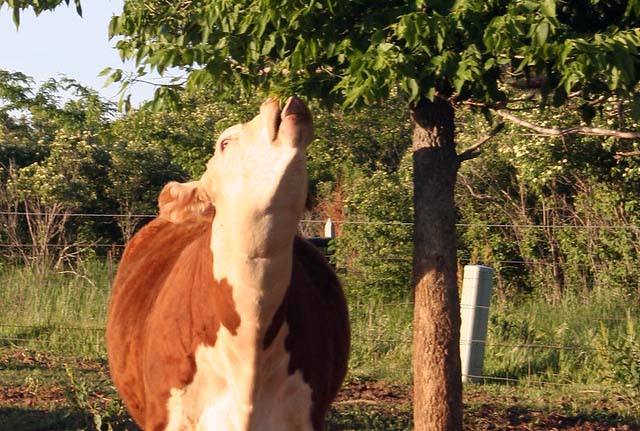
Curiosity can lead cattle to munch on tree leaves | Download this photo.
Cattle Chat: Tree leaves as a feed resource
K-State beef cattle experts discuss the nutritional value of leaves and the potential risks of eating them
June 14, 2022
By Lisa Moser, K-State Research and Extension news service
MANHATTAN, Kan. — Just as people like to try new foods on occasion, there are times when cattle opt to munch on the low branches of trees. But in a recent Cattle Chat podcast, the experts at Kansas State University’s Beef Cattle Institute, said that foraging on the tree leaves can pose potential health risks.
“There are times when cattle will eat leaves from low hanging tree branches or from downed limbs following a storm,” said Phillip Lancaster, beef cattle nutritionist. “While some leaves do provide good protein content, the digestibility is low.”
Lancaster said weather changes will impact the amount of tannic acid in the leaves. This acid causes the proteins in the rumen to bind more readily and has a negative impact on digestibility.
Veterinarian Bob Larson also cautioned producers that the leaves from certain trees can be toxic to cattle.
“Some of the tree varieties of concern are oak and cherry. With oak, both the acorns and the leaves are toxic. Additionally, pine needles from ponderosa pines can cause abortions in cows when they are consumed,” Larson said.
Along with the potential toxins, veterinarian Brian Lubbers said impaction, or things getting caught up in the digestive tract -- such as tree leaves, sticks and more -- can have negative consequences for cattle.
“It is not uncommon to see cattle choke on an osage orange hedge ball or have acorns or sticks become impacted in their digestive tract,” Lubbers said.
The experts said that while cattle can be curious and want to try to eat something new, oftentimes they experiment only when they are hungry.
“Cattle are preferential grazers and will most often eat the grass first,” said veterinarian Brad White. “It becomes a concern when we graze cattle in a heavily forested area where there is little grass on the ground.”
White noted: “While tree leaves may offer some nutritional value, producers need to be cautious of the toxic concerns and consider a rotational grazing plan so that there is plenty of grass available.”
To hear the full discussion on this topic, go to the Cattle Chat podcast online.

